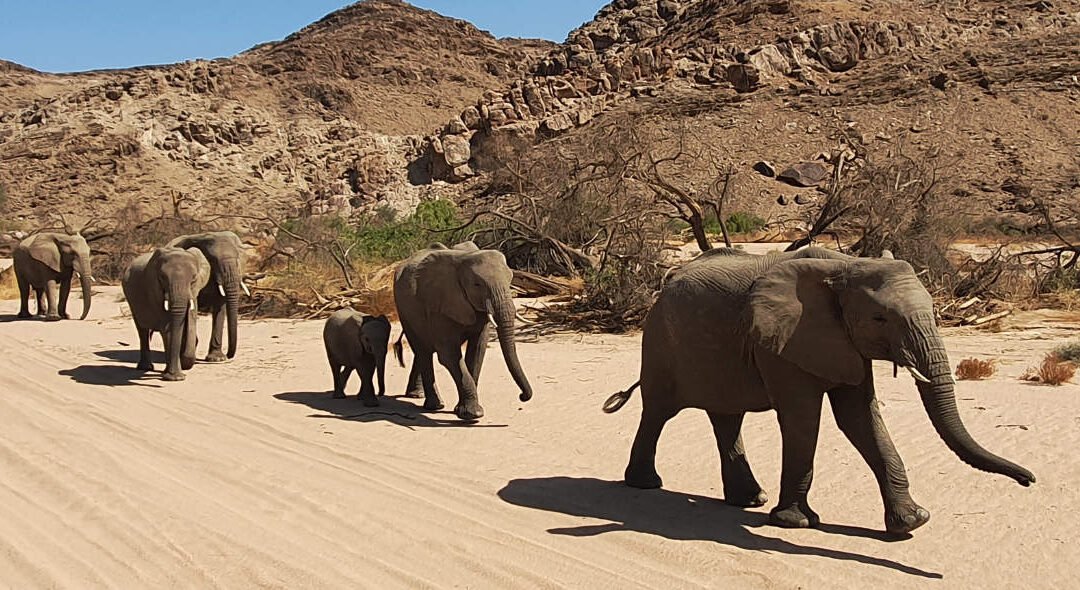I felt honored and touched and full of wonder as I watched a family of 10+ majestic elephants walk gracefully across a dry riverbed in a Namibian desert. These creatures are rare and precious and absolutely amazing.
These were definitely not THINGS or OBJECTS walking, but INDIVIDUALS, with their own special characteristics, and even names. (That’s right. The family we’ve met is well known to local guides, who have given them names and regularly monitor their well being). And this is true for all animals, even those whom we haven’t had a chance to meet and name. Yet, when it comes to law, we still treat animals as legal OBJECTS and PROPERTY, rather than PERSONS.
So, are elephants objects or persons? And should animals have rights?
We treat animals as legal objects. We should treat them as legal subjects instead.
You may believe that the law protects animals from harm in the United States, but that belief is false. There are few meaningful legal protections for most animals, and little if any enforcement of the laws that exist. The Animal Welfare Act, which is the main federal animal welfare law in the United States, exempts farmed animals, who represent about 98% of all captive animals in the country. So, while some animals, such as companion animals, enjoy limited protections, other animals mostly do not. Many state laws exempt farmed animals as well. This means companies and individuals can treat animals as they wish, as if those laws didn’t exist at all.
A deeper, related problem is that we classify nonhuman animals in the United States as legal objects, without the capacity for legal rights. This legal classification supports systematic neglect, exploitation, and massive killing and mutilation of animals on farms, in science and school labs, through hunting and fishing, as well as imprisoning the animals in zoos and circuses, taking away and destroying their habitats through practices such as deforestation, pollution, and the wildlife trade that harm humans and non-humans alike.

Happy the elephant is not a person, says U.S. court
Almost all of us grew up eating meat, wearing leather, and going to circuses and zoos. Many of us bought our beloved “pets” at pet shops and kept beautiful birds in cages. We ate (or still eat) McDonald’s burgers, and went (or go) fishing with our dads and uncles. We rarely if ever considered the impact of these actions on the animals involved. Today, more and more people demand that animals are granted certain rights that humans have.
An animal rights group, called Nonhuman Rights Project, argued before court that Happy, the elephant should be released from the Bronx zoo, where she’s been held captive for over 50 years. According to the activists, Happy is “an autonomous, cognitively complex elephant worthy of the right reserved in law for a person.”
Happy was born in the wild in Asia in the early 1970s, captured and brought as a one- year-old to the United States. Representatives of the Bronx Zoo argued that Happy is “neither illegally imprisoned nor a person”, but a well-cared-for elephant “respected as the magnificent creature she is”. And the New York’s top court has confirmed it, ruling that Happy cannot legally be considered a person.
The court’s decision means Happy will not be released to a more spacious sanctuary through a habeas corpus proceeding. The judges’ decision was that, while no one disputes that elephants are intelligent beings deserving of proper care and compassion, a writ of habeas corpus was intended to protect the liberty of human beings and did not apply to a nonhuman animal like Happy.
Habeas corpus is a law that states that a person cannot be kept in prison unless they have first been brought before a court of law, which decides whether it is legal for them to be kept in confinement.
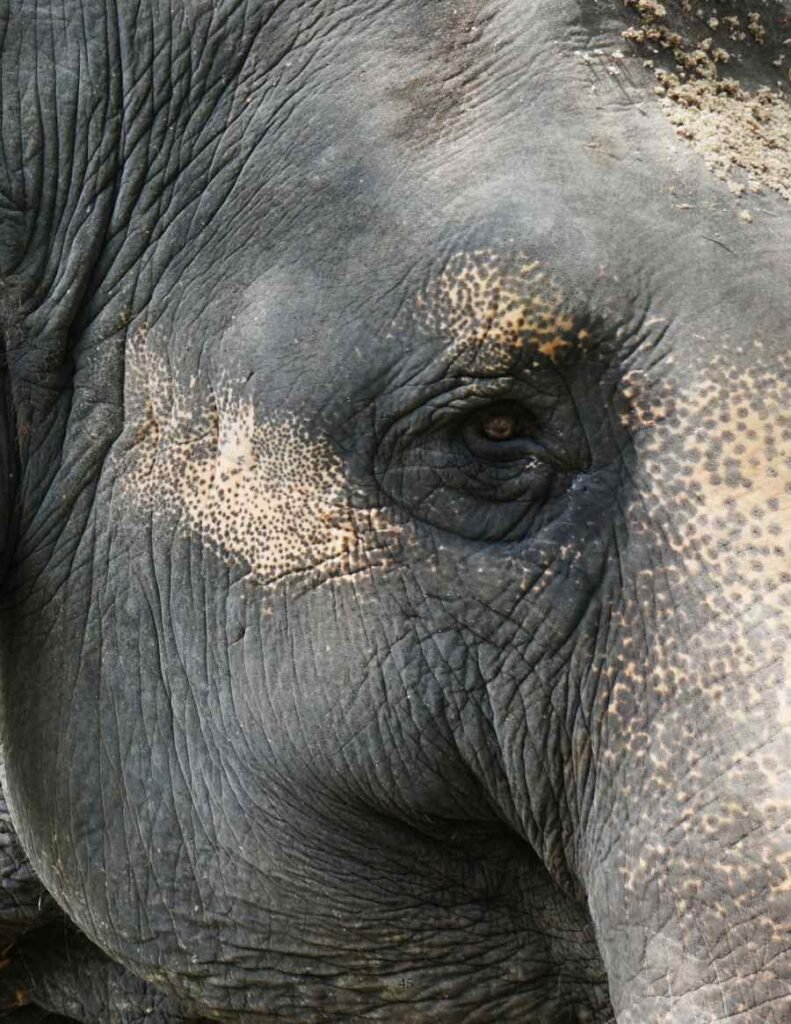

Why is there a problem with giving animals legal rights and treating them as legal persons?
Many people, including the judges, fear that giving animals rights will open the door to legal actions on behalf of other animals, including pets, animals on farms, in science labs, circuses, and in zoos, and “would have an enormous destabilizing impact on modern society”.
Unfortunately, those who benefit from the current system of abuse and exploitation are not giving in without a fight. Animal farming is a huge multibillion dollar industry, fiercely protected by those who benefit from it. And most of us willingly participate in this system by buying and using animal products, without giving it any thought.
Most of us are completely unaware of the abuse of animals that lies behind the food we eat and other products that we use that involve animal abuse and suffering, and we prefer to stay that way. We don’t want to see what’s behind the closed doors of animal farms, testing labs, zoos, or circuses with animal acts. The biggest abuses are happening on animal farms, with billions of animals being bread for the sole purpose of killing them. Eating meat, eggs, milk, or cheese is the end of a long process completely hidden from public view.
Most of people never associate a neat plastic package or aromatic dish with as living, breathing, and suffering animal. Product labels, ads, and television commercials show us animals happily grazing in green pastures, and frolicking in the sun, which is completely false reality compared to the horrors which these animals endure for their entire lives. But most of us never question them.
Although the Nonhuman Rights Project has lost this case and other similar cases, they are not giving up. The ruling from New York’s highest court cannot be appealed, but two judges wrote separate dissents, pointing out that the fact that Happy is an animal does not prevent her from having legal rights. They stated that Happy was being held in “an environment that is unnatural to her and that does not allow her to live her life” and that “her captivity is inherently unjust and inhumane. It is an affront to a civilized society, and every day she remains a captive—a spectacle for humans—we, too, are diminished”. The fact that they managed to persuade these judges to their arguments, is a great reason for hope.
All animals matter. They have an inherent worth, a value completely separate from their usefulness to humans.
Every creature with a will to live has a right to live free from pain and suffering.
Most of us would agree that animals are not objects, but living beings. It is obvious to us that all animals have the ability to suffer; that they have the capacity to feel pain, pleasure, fear, frustration, loneliness, and motherly love. This means that they matter morally, and whenever we consider doing something that would interfere with their interests, we are morally obligated to take them into account.
Animal use is so deeply ingrained in our culture, and some of us can’t even imagine what our lives would look like if things were different. But we cannot heal our civilization and our planet without improving our relationship with the animals and the entire natural world.
Things are already beginning to shift for the animals. For example, in Spain, animals have already been granted the status of “sentient beings”, and will no longer be considered as “objects” by the law, and as such will have a different legal standing than an inanimate object.
Millions of people switch to plant-based diet and choose the vegan lifestyle for the animals and the planet. Veganism is a way of living that attempts to exclude all forms of animal use, whether for food, clothing, entertainment, or any other purpose. That’s why a vegan diet eliminates all animal products, including meat, eggs, and dairy.
Initiatives, such as the Plant Based Treaty, the Half Earth Project and 30 by 30 Goal, are attempting to improve the situation for all animals, heal the planet, and reverse the climate change. Keep reading to find out more about them.
How Can We Help Elephants?
Unfortunately, there are no quick and easy solutions to the problems that elephants are facing. Individuals like you and I can’t do much on our own, but that doesn’t mean that we are powerless.
Quite the opposite.
Even though we need systemic solutions to fix global problems, such as the climate change, the global energy crisis, pollution, poaching, deforestation, ocean depletion, and others; without individuals who are speaking up, demanding action and taking matters into their hands—things won’t be changing fast enough.
One of the things each of us can do is to go on a plant-exclusive (vegan) diet.
There are 8 billions of humans on this planet, killing 80+ billions of land animals plus countless sea creatures, and if each of us wants to be a predator then we need a couple more planets.
Become an herbivore–just like elephants–for all animals, human and non-human, and our planet.
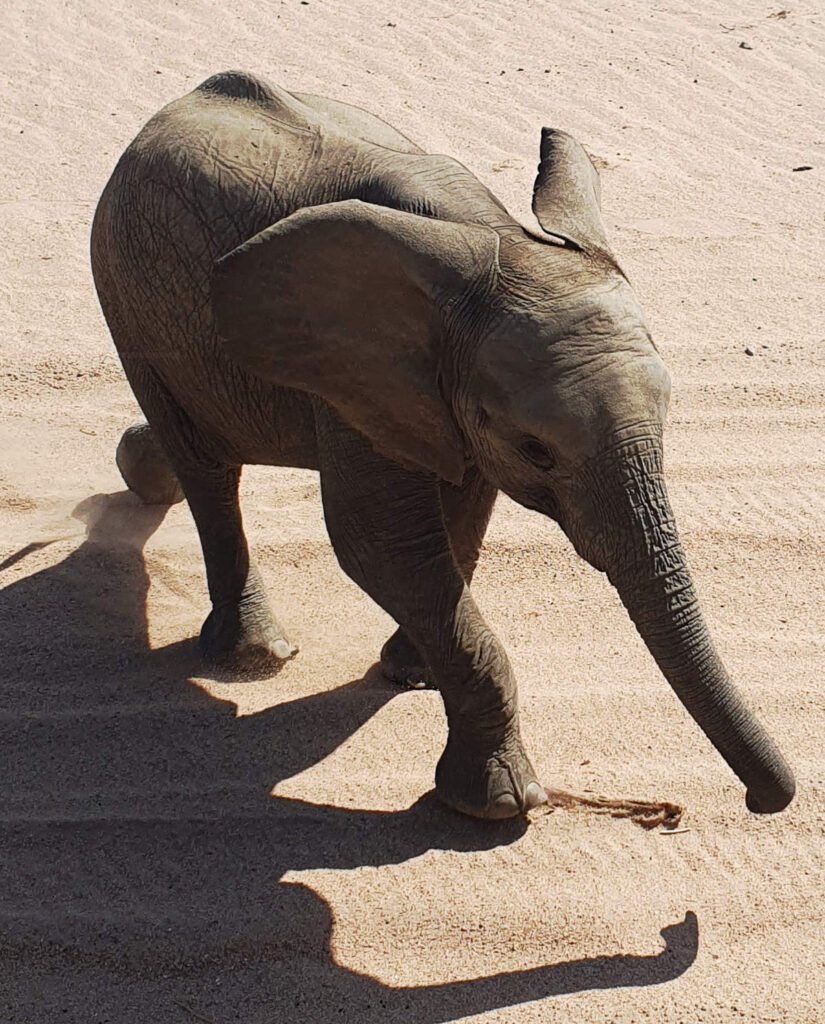
#elephantlove #elephantsofinstagram #loveelephants #herbivore #namibia #govegan
28 Interesting Facts about Elephants
As I recently published an updated edition of my book about “Elephants! And Their Secrets”, I learned so much about these amazing beings! Here are 28 interesting facts about them that not many people know about:
1. Remarkable Memory: Elephants are known for their exceptional memory. They can remember and recognize individual humans and other elephants for many years, sometimes even decades. They can remember the locations of water holes and navigate through vast landscapes to find them, even during periods of drought. This memory is crucial for their survival in environments with fluctuating water availability.
2. Incredible Trunk Abilities: An elephant’s trunk is a versatile and highly sensitive appendage. Apart from using it for feeding and drinking, elephants employ their trunks for social interactions, such as touching and caressing other elephants. They can also use their trunks for communication, emitting low-frequency sounds that are crucial for coordinating group activities.
3. Tool Use: Elephants exhibit tool use, a behavior once thought to be exclusive to humans and a few other species. They have been observed using branches to swat flies or scratch themselves and modifying sticks for various purposes.
4. Self-awareness: Elephants have shown signs of self-awareness, a cognitive ability that only a few species possess. They can recognize themselves in mirrors, demonstrating a level of self-awareness previously believed to be limited to humans, great apes, and dolphins.
5. Social Complexity: Elephant herds exhibit complex social structures. Led by the oldest and most experienced female, the matriarch, the herd includes relatives of different ages. The social bonds within the herd are strong, and elephants engage in various behaviors such as play, grooming, protecting each other, caring for injured members, and mourning their dead, contributing to the overall well-being of the group.
6. Unique Teeth: Elephant tusks are elongated incisor teeth that continue to grow throughout their lives. The tusks are used for various purposes, including digging for water, stripping bark from trees, and as a display of dominance. Unfortunately, this amazing feature has made elephants a target for ivory poaching.
7. Vocalizations Beyond Human Hearing: Elephants communicate using a variety of vocalizations, including infrasound, which is below the threshold of human hearing. These low-frequency rumbles can travel over long distances, allowing elephants to communicate with each other even in dense environments like forests.
8. Elephant Communication through Seismic Waves: In addition to vocalizations and ground vibrations, elephants can communicate using seismic waves. They produce low-frequency signals, creating vibrations that travel through the ground. This seismic communication allows elephants to share information across large distances, especially in areas with dense vegetation.
9. Sophisticated Communication: Elephants communicate also through a sophisticated system of body language, including gestures and movements of the trunk, ears, and tail. Researchers are continually decoding these communication signals to gain insights into the complex social dynamics within elephant herds.
10. Sensitive Feet and Vibrations: Elephants have highly sensitive feet with a soft padding, allowing them to move quietly. This adaptation makes them surprisingly stealthy despite their size. They can also detect vibrations through the ground, enhancing their ability to communicate and navigate their surroundings, particularly in low-visibility environments.
11. Herbivores with a Voracious Appetite: Elephants are herbivores with a voracious appetite, consuming an average of 300 pounds (136 kilograms) of food per day. Their diet consists of a variety of vegetation, including grasses, fruits, and tree branches.
12. Importance of Elephant Poop: Elephant dung plays a vital role in maintaining ecosystem health. As herbivores, elephants consume large quantities of vegetation, and their dung serves as a nutrient-rich fertilizer. The seeds from the plants they eat often survive the digestive process and germinate in the fertile environment of the dung, contributing to plant regeneration.
13. Mineral-Seeking Behavior: Elephants engage in a behavior known as geophagy, where they dig for minerals and ingest soil. This behavior is believed to supplement their diet with essential minerals and nutrients not readily available in their regular food sources. The specific reasons for geophagy are not fully understood but highlight the complexity of elephant dietary needs.
14. Dermal Senses: Elephants may have tough skin, but the abundance of dermal senses or receptors makes them highly sensitive to touch.
15. Longest Pregnancy in Land Mammals: The gestation period of an elephant is the longest among land mammals, lasting approximately 22 months. This extended period is necessary for the development of the elephant’s large and complex brain, a crucial organ for their survival and adaptation to their environment.
16. Remarkable Problem-Solving Skills: Elephants showcase remarkable problem-solving skills. They have been observed using tools, such as branches, to swat flies or scratch themselves. Additionally, elephants are known to cooperate and coordinate efforts when faced with challenges, displaying a level of cognitive complexity.
17. Excellent Swimmers: Despite their large size, elephants are excellent swimmers and enjoy water play. They can swim for long distances and use their trunk as a snorkel while crossing deep water. This ability is essential for their survival in regions where water is a significant part of their habitat. Water is not only essential for their survival but also provides a source of enjoyment and social interaction.
18. Ancient Ancestors: Elephants have ancient relatives that once roamed the Earth. The mastodons and mammoths, distant cousins of modern elephants, lived during the Pleistocene epoch. Mastodons, in particular, were stocky and had different teeth compared to today’s elephants.
19. Keystone Species and Ecosystem Engineers: Elephants play a crucial role as keystone species and ecosystem engineers. Their feeding habits, including uprooting trees and breaking branches, create clearings in forests, influencing the landscape and promoting biodiversity by allowing different plant species to thrive in these gaps.
20. Legal Recognition as Persons: In 2019, a landmark case in the United States saw the Nonhuman Rights Project filing a habeas corpus petition in a Connecticut court, arguing that three elephants—Beulah, Karen, and Minnie—deserved recognition as legal persons. While the case did not grant them personhood, it raised significant ethical questions about the treatment of elephants in captivity.
21. In 2020 the Bronx Zoo case involved a habeas corpus petition filed by the Nonhuman Rights Project on behalf of Happy, an Asian elephant living at the Bronx Zoo. The case aimed to recognize Happy as a legal person with the right to bodily liberty. While the court did not grant personhood, it raised awareness about captive elephant welfare.
22. Ancient Elephant Graveyards: In certain regions, ancient elephant graveyards have been discovered, containing the remains of numerous elephants. While the exact reasons for these graveyards remain a mystery, they suggest that elephants may have exhibited communal behavior or were drawn to specific locations for unknown reasons.
23. Tuskless Elephants: Not all elephants have tusks. In some populations, a significant percentage of individuals are naturally tuskless. This trait is often hereditary and can be more prevalent in areas where there is higher human-elephant conflict, as tuskless elephants may be less targeted by poachers.
24. Elephant Empathy: Elephants are known for their high level of empathy. They demonstrate a range of emotions, including joy, grief, and compassion. There are instances of elephants showing empathy towards distressed herd members, providing comfort and support.
25. Depression and PTSD in Elephants: Elephants, particularly those in captivity, can experience mental health issues such as depression and post-traumatic stress disorder (PTSD). Traumatic events like poaching, captivity, or witnessing harm to herd members can lead to aggression or withdrawn behavior. Recognizing and addressing these mental health challenges is crucial for the well-being of elephants in captivity.
26. Historical Elephant Population: Estimates suggest that the historical elephant population was significantly larger than the current numbers. In the early 20th century, there were approximately 5 million elephants in Africa alone. However, due to factors such as habitat loss and poaching for ivory, the current population is a fraction of what it used to be.
27. Endangered Status: African elephants are currently listed as vulnerable, while Asian elephants are classified as endangered by the International Union for Conservation of Nature (IUCN). The main threats to elephants include habitat loss, human-elephant conflict, and poaching for ivory. Conservation efforts are underway to protect and preserve these majestic creatures.
28. Economic Impact in Tourism: Elephants contribute significantly to local economies through ecotourism. Many countries rely on elephant tourism, offering opportunities for visitors to observe and appreciate these majestic animals in their natural habitats. This economic incentive provides a conservation motive, helping protect wild elephant populations and their ecosystems.
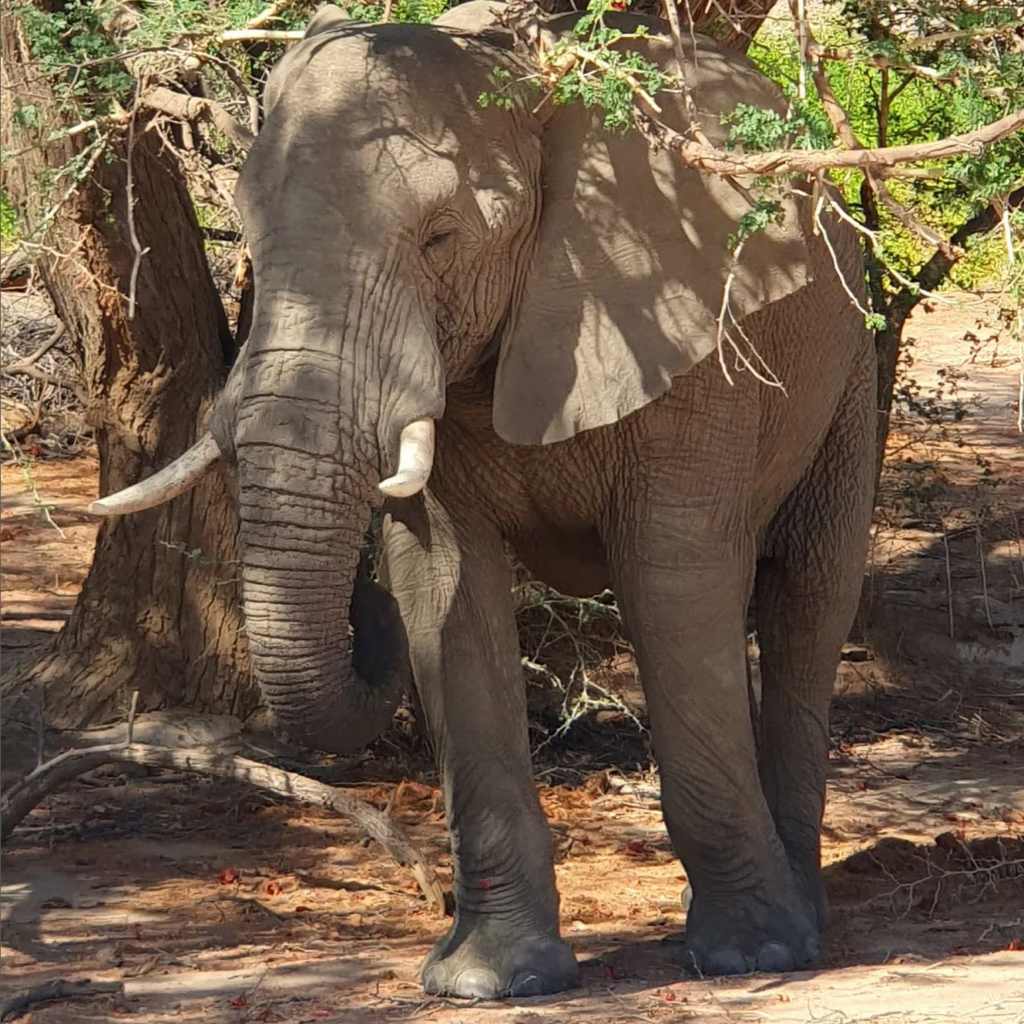
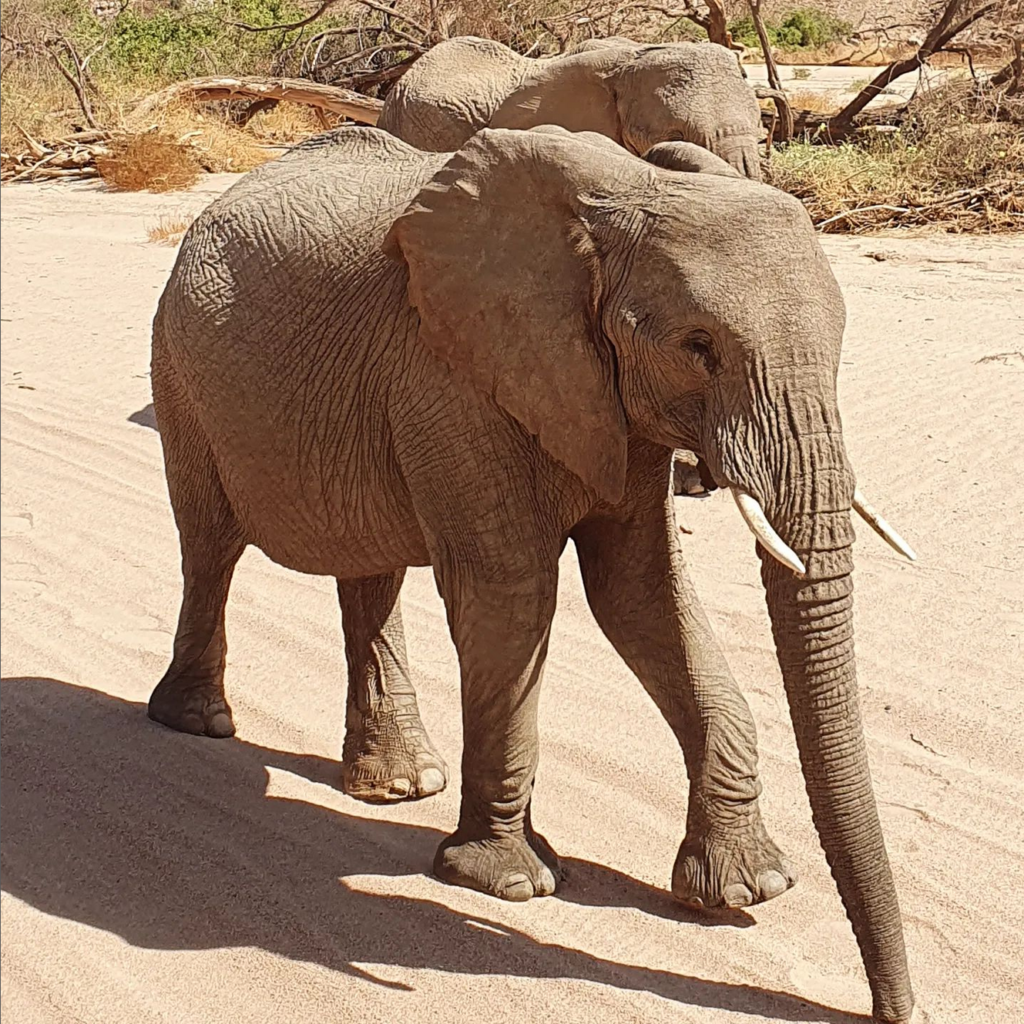
P.S. And in case you’re wondering, I do feel guilty at times for traveling long distances by air and car, which contributes to climate change and pollution of the environment, however, I am also hopeful that supporting ecotourism and local communities contributes to the preservation of many species, including elephants. If you would like to learn more, check out the Food for Thought Podcast Episode “Is Wildlife Tourism Good or Bad for Animals?” (also available on Youtube, Apple, Podcast Addict, and other platforms). I listened to it as we drove through Namibian desert, and it provided me with answers to many questions I had. Plus, I really enjoyed hearing about the history of the mountain gorillas in Rwanda.

